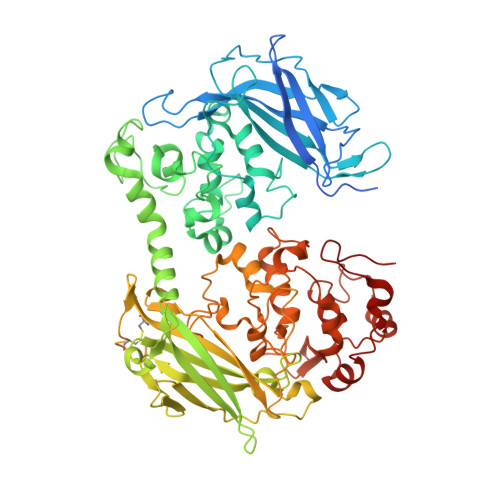Nanosecond heme-to-heme electron transfer rates in a multiheme cytochrome nanowire reported by a spectrally unique His/Met-ligated heme.
van Wonderen, J.H., Adamczyk, K., Wu, X., Jiang, X., Piper, S.E.H., Hall, C.R., Edwards, M.J., Clarke, T.A., Zhang, H., Jeuken, L.J.C., Sazanovich, I.V., Towrie, M., Blumberger, J., Meech, S.R., Butt, J.N.(2021) Proc Natl Acad Sci U S A 118
- PubMed: 34556577
- DOI: https://doi.org/10.1073/pnas.2107939118
- Primary Citation of Related Structures:
7O7G - PubMed Abstract:
Proteins achieve efficient energy storage and conversion through electron transfer along a series of redox cofactors. Multiheme cytochromes are notable examples. These proteins transfer electrons over distance scales of several nanometers to >10 μm and in so doing they couple cellular metabolism with extracellular redox partners including electrodes. Here, we report pump-probe spectroscopy that provides a direct measure of the intrinsic rates of heme-heme electron transfer in this fascinating class of proteins. Our study took advantage of a spectrally unique His/Met-ligated heme introduced at a defined site within the decaheme extracellular MtrC protein of Shewanella oneidensis We observed rates of heme-to-heme electron transfer on the order of 10 9 s -1 (3.7 to 4.3 Å edge-to-edge distance), in good agreement with predictions based on density functional and molecular dynamics calculations. These rates are among the highest reported for ground-state electron transfer in biology. Yet, some fall 2 to 3 orders of magnitude below the Moser-Dutton ruler because electron transfer at these short distances is through space and therefore associated with a higher tunneling barrier than the through-protein tunneling scenario that is usual at longer distances. Moreover, we show that the His/Met-ligated heme creates an electron sink that stabilizes the charge separated state on the 100-μs time scale. This feature could be exploited in future designs of multiheme cytochromes as components of versatile photosynthetic biohybrid assemblies.
Organizational Affiliation:
School of Chemistry, University of East Anglia, Norwich Research Park, Norwich NR4 7TJ, United Kingdom.


















